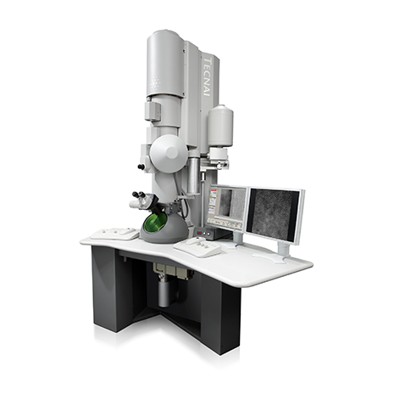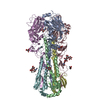+ Open data
Open data
- Basic information
Basic information
| Entry |  | |||||||||
|---|---|---|---|---|---|---|---|---|---|---|
| Title | Negative stain of cH5/1 HA in complex with 31.b.09 Fab | |||||||||
 Map data Map data | Negative stain map of cH5/1 HA in complex with monoclonal Fab 31.b.09 | |||||||||
 Sample Sample |
| |||||||||
 Keywords Keywords | influenza / hemmagglutinin / HA / Fab complex / viral fusion protein / chimeric hemmagglutinin / VIRAL Protein | |||||||||
| Biological species |  Influenza A virus (A/California/04/2009(H1N1)) / Influenza A virus (A/California/04/2009(H1N1)) /  Homo sapiens (human) Homo sapiens (human) | |||||||||
| Method | single particle reconstruction / negative staining / Resolution: 20.0 Å | |||||||||
 Authors Authors | Han J / Rodriguez AJ / Ward AB | |||||||||
| Funding support |  United States, 1 items United States, 1 items
| |||||||||
 Citation Citation |  Journal: Proc Natl Acad Sci U S A / Year: 2025 Journal: Proc Natl Acad Sci U S A / Year: 2025Title: Structural characterization of influenza group 1 chimeric hemagglutinins as broad vaccine immunogens. Authors: Yen Thi Kim Nguyen / Xueyong Zhu / Julianna Han / Alesandra J Rodriguez / Weina Sun / Wenli Yu / Peter Palese / Florian Krammer / Andrew B Ward / Ian A Wilson /   Abstract: Chimeric hemagglutinins (cHA) appear to be promising for the design and development of universal influenza vaccines. Influenza A group 1 cHAs, cH5/1, cH8/1, and cH11/1, comprising an H1 stem attached ...Chimeric hemagglutinins (cHA) appear to be promising for the design and development of universal influenza vaccines. Influenza A group 1 cHAs, cH5/1, cH8/1, and cH11/1, comprising an H1 stem attached to either an H5, H8, or H11 globular head, have been used sequentially as vaccine immunogens in human clinical trials and induced high levels of broadly protective antibodies. Using X-ray crystallography and negative-stain electron microscopy, we determined structures of cH5/1, cH8/1, and cH11/1 HAs in their apo (unliganded) and antibody Fab-bound states. Stem-reactive antibodies 3E1 and 31.b.09 recognize their cognate epitopes in cH5/1, cH8/1, and cH11/1 HAs. However, with cH5/1, the head domains are rotated by 35 to 45° around the threefold axis of the HA trimer compared to native HA with a more splayed-open conformation at the stem base. cH11/1 with 3E1 is structurally more native-like but resembles cH5/1 with 31.b.09, whereas cH8/1 with 31.b.09 exhibited a range of closed-to-open stem configurations with some separation of head and stem domains. Furthermore, all of these group 1 cHAs effectively bound a broad head trimer interface antibody and other broad stem antibodies. Thus, the cHAs exhibit structural plasticity without compromising the stem and head trimer interface epitopes for elicitation of influenza A group 1 cross-reactive antibodies. | |||||||||
| History |
|
- Structure visualization
Structure visualization
| Supplemental images |
|---|
- Downloads & links
Downloads & links
-EMDB archive
| Map data |  emd_46835.map.gz emd_46835.map.gz | 26.5 MB |  EMDB map data format EMDB map data format | |
|---|---|---|---|---|
| Header (meta data) |  emd-46835-v30.xml emd-46835-v30.xml emd-46835.xml emd-46835.xml | 17.3 KB 17.3 KB | Display Display |  EMDB header EMDB header |
| Images |  emd_46835.png emd_46835.png | 83.5 KB | ||
| Filedesc metadata |  emd-46835.cif.gz emd-46835.cif.gz | 4.4 KB | ||
| Others |  emd_46835_half_map_1.map.gz emd_46835_half_map_1.map.gz emd_46835_half_map_2.map.gz emd_46835_half_map_2.map.gz | 26.5 MB 26.4 MB | ||
| Archive directory |  http://ftp.pdbj.org/pub/emdb/structures/EMD-46835 http://ftp.pdbj.org/pub/emdb/structures/EMD-46835 ftp://ftp.pdbj.org/pub/emdb/structures/EMD-46835 ftp://ftp.pdbj.org/pub/emdb/structures/EMD-46835 | HTTPS FTP |
-Validation report
| Summary document |  emd_46835_validation.pdf.gz emd_46835_validation.pdf.gz | 738.6 KB | Display |  EMDB validaton report EMDB validaton report |
|---|---|---|---|---|
| Full document |  emd_46835_full_validation.pdf.gz emd_46835_full_validation.pdf.gz | 738.2 KB | Display | |
| Data in XML |  emd_46835_validation.xml.gz emd_46835_validation.xml.gz | 11.1 KB | Display | |
| Data in CIF |  emd_46835_validation.cif.gz emd_46835_validation.cif.gz | 13.1 KB | Display | |
| Arichive directory |  https://ftp.pdbj.org/pub/emdb/validation_reports/EMD-46835 https://ftp.pdbj.org/pub/emdb/validation_reports/EMD-46835 ftp://ftp.pdbj.org/pub/emdb/validation_reports/EMD-46835 ftp://ftp.pdbj.org/pub/emdb/validation_reports/EMD-46835 | HTTPS FTP |
-Related structure data
- Links
Links
| EMDB pages |  EMDB (EBI/PDBe) / EMDB (EBI/PDBe) /  EMDataResource EMDataResource |
|---|
- Map
Map
| File |  Download / File: emd_46835.map.gz / Format: CCP4 / Size: 34.3 MB / Type: IMAGE STORED AS FLOATING POINT NUMBER (4 BYTES) Download / File: emd_46835.map.gz / Format: CCP4 / Size: 34.3 MB / Type: IMAGE STORED AS FLOATING POINT NUMBER (4 BYTES) | ||||||||||||||||||||||||||||||||||||
|---|---|---|---|---|---|---|---|---|---|---|---|---|---|---|---|---|---|---|---|---|---|---|---|---|---|---|---|---|---|---|---|---|---|---|---|---|---|
| Annotation | Negative stain map of cH5/1 HA in complex with monoclonal Fab 31.b.09 | ||||||||||||||||||||||||||||||||||||
| Projections & slices | Image control
Images are generated by Spider. | ||||||||||||||||||||||||||||||||||||
| Voxel size | X=Y=Z: 1.77 Å | ||||||||||||||||||||||||||||||||||||
| Density |
| ||||||||||||||||||||||||||||||||||||
| Symmetry | Space group: 1 | ||||||||||||||||||||||||||||||||||||
| Details | EMDB XML:
|
-Supplemental data
-Half map: Negative stain half map B of cH5/1 HA...
| File | emd_46835_half_map_1.map | ||||||||||||
|---|---|---|---|---|---|---|---|---|---|---|---|---|---|
| Annotation | Negative stain half map B of cH5/1 HA in complex with monoclonal Fab 31.b.09 | ||||||||||||
| Projections & Slices |
| ||||||||||||
| Density Histograms |
-Half map: Negative stain half map A of cH5/1 HA...
| File | emd_46835_half_map_2.map | ||||||||||||
|---|---|---|---|---|---|---|---|---|---|---|---|---|---|
| Annotation | Negative stain half map A of cH5/1 HA in complex with monoclonal Fab 31.b.09 | ||||||||||||
| Projections & Slices |
| ||||||||||||
| Density Histograms |
- Sample components
Sample components
-Entire : cH5/1 HA in complex with 31.b.09 Fab
| Entire | Name: cH5/1 HA in complex with 31.b.09 Fab |
|---|---|
| Components |
|
-Supramolecule #1: cH5/1 HA in complex with 31.b.09 Fab
| Supramolecule | Name: cH5/1 HA in complex with 31.b.09 Fab / type: complex / ID: 1 / Parent: 0 |
|---|---|
| Source (natural) | Organism:  Influenza A virus (A/California/04/2009(H1N1)) Influenza A virus (A/California/04/2009(H1N1)) |
-Supramolecule #2: cH5/1 HA
| Supramolecule | Name: cH5/1 HA / type: organelle_or_cellular_component / ID: 2 / Parent: 1 |
|---|---|
| Source (natural) | Organism:  Influenza A virus (A/California/04/2009(H1N1)) Influenza A virus (A/California/04/2009(H1N1)) |
-Supramolecule #3: 31.b.09 Fab
| Supramolecule | Name: 31.b.09 Fab / type: organelle_or_cellular_component / ID: 3 / Parent: 1 |
|---|---|
| Source (natural) | Organism:  Homo sapiens (human) Homo sapiens (human) |
-Experimental details
-Structure determination
| Method | negative staining |
|---|---|
 Processing Processing | single particle reconstruction |
| Aggregation state | particle |
- Sample preparation
Sample preparation
| Concentration | 0.015 mg/mL |
|---|---|
| Buffer | pH: 7.4 |
| Staining | Type: NEGATIVE / Material: 2% w/v uranyl formate |
| Grid | Model: Homemade / Material: COPPER / Mesh: 400 / Support film - Material: CARBON |
- Electron microscopy
Electron microscopy
| Microscope | FEI TECNAI F20 |
|---|---|
| Image recording | Film or detector model: TVIPS TEMCAM-F416 (4k x 4k) / Average electron dose: 25.0 e/Å2 |
| Electron beam | Acceleration voltage: 200 kV / Electron source:  FIELD EMISSION GUN FIELD EMISSION GUN |
| Electron optics | Illumination mode: FLOOD BEAM / Imaging mode: DARK FIELD / Nominal defocus max: 2.0 µm / Nominal defocus min: -2.0 µm |
| Sample stage | Specimen holder model: SIDE ENTRY, EUCENTRIC |
| Experimental equipment |  Model: Tecnai F20 / Image courtesy: FEI Company |
- Image processing
Image processing
| Startup model | Type of model: PDB ENTRY PDB model - PDB ID: |
|---|---|
| Final reconstruction | Resolution.type: BY AUTHOR / Resolution: 20.0 Å / Resolution method: FSC 0.5 CUT-OFF / Software - Name: RELION (ver. 3.0) / Number images used: 5422 |
| Initial angle assignment | Type: MAXIMUM LIKELIHOOD |
| Final angle assignment | Type: MAXIMUM LIKELIHOOD |
 Movie
Movie Controller
Controller

















 Z (Sec.)
Z (Sec.) Y (Row.)
Y (Row.) X (Col.)
X (Col.)





































